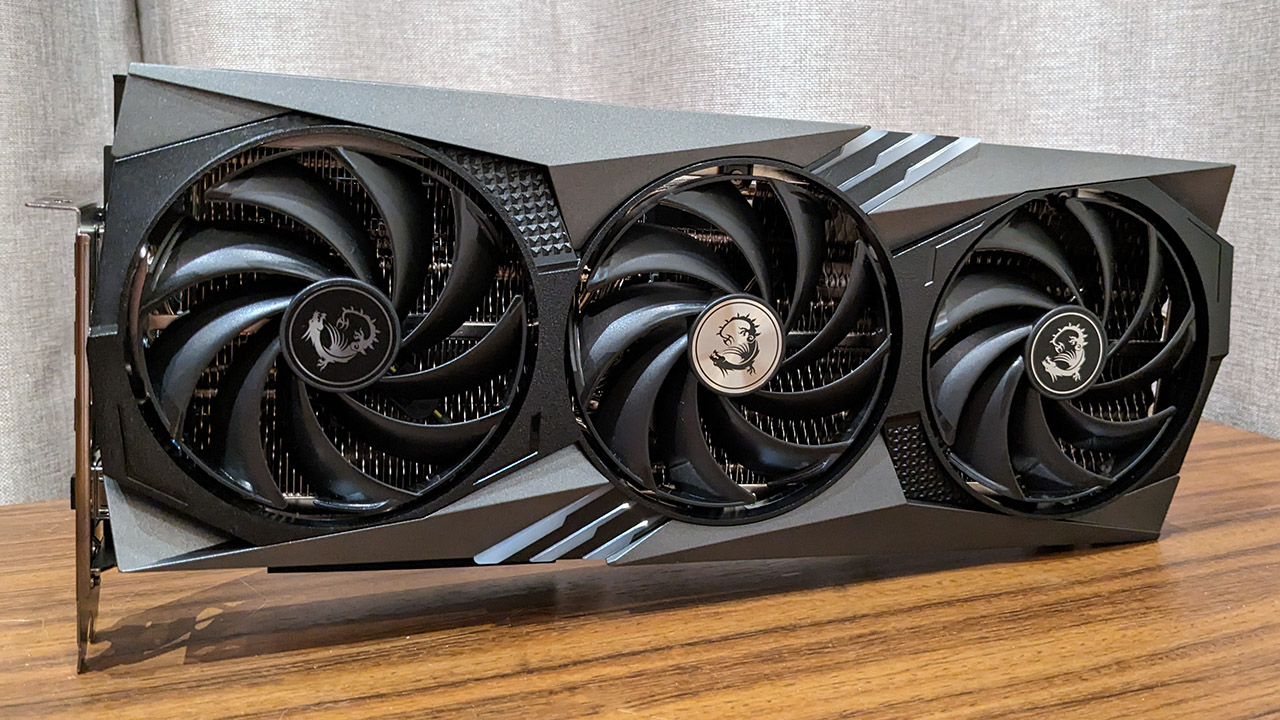
Look here if you're after a silent and cool running RTX 4070.
Isn’t it great to see capable graphics cards available at prices that won’t make you keel over in shock? Okay, they’re not exactly cheap, but given the ludicrous GPU market of a couple of years back, GeForce RTX 4070s starting at around $600 / £600 / AU$999 are a dead set bargain. While you can’t call a $600 GPU an affordable one, it’s good to see the latest generation cards hitting price points that are more attractive than we’ve seen in a long time.
Do check out our man James’ RTX 4070 Founders Edition review. Dave goes into some of the more technical details and concludes the RTX 4070 delivers RTX 3080 performance, while running cooler, quieter, and more efficiently than the last-gen hero. Most importantly, the RTX 4070 comes in at a lower price point. You also get the frame generation wizardry of DLSS 3.0.
If you add all those things together, it’s fairly easy to make a case for the RTX 4070. On the flipside, the RTX 4070 really should compare favorably to the RTX 3080. It’d be a turkey if an xx70 card couldn’t beat out the previous generations’ xx80.
And today, here for review I have MSI’s RTX 4070 flavor, specifically the MSI GeForce RTX 4070 Gaming X Trio. The Gaming X series often impresses me, usually delivering a near perfect balance of temperatures and low noise levels that allow the card to hold high boost clocks without much compromise. But given the RTX 4070 is a highly efficient GPU, is the big triple fan Gaming X Trio cooler really necessary?
The Gaming X Trio carries a lot of the design cues of its higher end stablemates including the RTX 4070 Ti Gaming X Trio. It combines a stylish and angular design with a good splash of RGB lighting, a custom PCB and a factory overclock.
MSI GeForce RTX 4070 Gaming X Trio overview and specs
(Image credit: Future)
The MSI RTX 4070 Gaming X Trio, like all RTX 4070s, is based on the 5nm AD104 GPU, albeit a heavily cut down version of the one found in the RTX 4070 Ti. It comes with 5,888 CUDA cores, 46 RT cores, and 184 Tensor cores. This compares to the 7,680 CUDA cores, 60 RT cores and 240 Tensor cores of the RTX 4070 Ti.
Thankfully, Nvidia didn’t gut the memory subsystem. Both the 4070 and the 4070 Ti come with the same 12GB of 21Gbps memory over a 192-bit memory bus. However, no matter how much GDDR memory speeds improve, the idea of a card with a 192-bit bus costing $600 still irritates me.
The MSI Gaming X Trio comes with a factory overclock at 2,610MHz, a decent 135MHz increase over the 2,475MHz reference speed. The TDP of the card is a very respectable 215W, a modest 15W increase over the TDP of the 4070 Founders Edition and over 100W less than the RTX 3080. The MSI Gaming X Trio includes the now common 16-pin 12VHPWR power connector, but MSI ships a 2x 8-pin power adapter for use with older power supplies. For its part, MSI recommends a minimum 650W power supply.
Like most RTX 4070s, and indeed most RTX 40-series cards as a whole, the MSI includes three DP 1.4 ports plus one HDMI 2.1 port. DP 2.0 would be nice, but given the RTX 4070 isn’t really a high FPS 4K card, let alone an 8K capable one, its omission is not that important.
(Image credit: Future)
(Image credit: Future)
(Image credit: Future)
(Image credit: Future)
(Image credit: Future)
(Image credit: Future)
In all honesty, there’s no need for the card to be this big.
The card is a big one, as is usually the case with triple fan cards. It measures 338 x 141 x 52 mm, requiring three slots, though it doesn’t need the full three slots, giving it some welcome breathing room if used with an adjacent expansion card.
In all honesty, there’s no need for the card to be this big. The PCB only takes up half the length of the card, leaving a large cutout at the rear of the card. But still, it’s better to over deliver on the cooling capacity than under deliver. It is something to note if you’re after a RTX 4070 for a small form factor build though, which is something the regular versions are ideal for.
The card doesn’t have the bulk and weight of the more powerful RTX 4070 Gaming X Trio’s, but it’s still a premium design, with attractive RGB elements, a backplate and a tastefully designed shroud.
Even if it is overkill, the cooler is excellent. The small 295mm² AD104 die is cooled by six heatpipes, with pads for the VRM circuitry and memory chips too. It’s one of the quietest cards I’ve ever tested, and with a peak 3DMark Speedway temperature of just 57°C after 10 minutes of running, its absolute proof that a RTX 4070 can get away with a smaller dual fan, dual slot cooler.
The MSI RTX 4070 Gaming X Trio comes with a compact and capable PCB that includes 9+2 phase VRM with 55A stages. A 295mm² die with a 192-bit bus and a relatively basic PCB shouldn’t have a huge bill of materials. I hope Nvidia drops the price of RTX 4070 cards in the months ahead as I’m sure there’s plenty of margin to do so.
MSI GeForce RTX 4070 Gaming X Trio benchmarks and performance
I have tested the RTX 4070 Gaming X Trio with a selection of cards that I have on hand, however, the RTX 3080 I have encountered some issues so I had to omit it from my testing.
CPU: Intel Core i9 12900K
Motherboard: Asus ROG Maximus Z690 Apex
RAM: 2x 16GB G.Skill Trident-Z DDR5-6000 C36
Storage: 2TB Seagate FireCuda 530
Cooling: Cooler Master PL360 Flux 360mm AIO
PSU: Corsair AX1000
The temperatures of the Gaming X Trio are seriously impressive and a testament to the overbuilt nature of the card. The power efficiency is excellent too and in terms of performance per watt, the RTX 4070 is awesome. Well done Nvidia.
The low operating temperature of the card allows it to maintain high boost clocks essentially indefinitely. The MSI Gaming X Trio has a rated boost clock of 2,610MHz, but my sample was able to sit at an average of 2,785MHz and with a peak temperature of just 57 degrees, the card has a lot of temperature overhead. In fact the MSI’s fans were spinning at just 30%!
Is it a criticism of the MSI Gaming X Trio? Well, if a cooler can be too good, then yes I guess it is, but it’s a positive criticism!
Synthetic gaming performance
1080p Gaming Performance
1440p Gaming Performance
(Image credit: Future)
4K Gaming Performance
MSI GeForce RTX 4070 Gaming X Trio analysis
(Image credit: Future)
The RTX 4070 is able to run games at anywhere from 1080p up to 4K, though at the highest resolutions the most demanding modern titles will require you to dial back the settings a little or enable DLSS to maintain smooth frame rates.
At high resolutions, the card can encounter some memory bandwidth limitations, and this is a reason a card like the RTX 3080 Ti remains a compelling option. The 10GB limitation of the base RTX 3080 is becoming increasingly apparent though. Back to the RTX 4070, is 12GB enough in the long term? I can’t really answer that without knowing how future games will perform, but with 8GB cards hitting limitations in some modern (or particularly unoptimized) titles, 16GB would have been preferable. But hey, Nvidia will want you to buy an RTX 50 card, right?
At 1440p, less demanding titles or ones without heavy RT effects will hum along at high frame rates, however the RTX 4070 Ti begins to pull further ahead of the RTX 4070 due to its superior shading performance.
It’s only really when we get to 4K the card begins to struggle at high settings in more intensive titles, but that can be overcome thanks to the wizardry of DLSS frame generation technology or dropping back to medium settings.
At high resolutions, the card can encounter some memory bandwidth limitations, and this is a reason a card like the RTX 3080 Ti remains a compelling option. The 10GB limitation of the base RTX 3080 is becoming increasingly apparent though. Back to the RTX 4070, is 12GB enough in the long term? I can’t really answer that without knowing how future games will perform, but with 8GB cards hitting limitations in some modern (or particularly unoptimized) titles, 16GB would have been preferable. But hey, Nvidia will want you to buy an RTX 50-series card, right?
Of course, if you’re playing popular games like Valorant or Overwatch, the RTX 4070 won’t limit you at all.
MSI GeForce RTX 4070 Gaming X Trio verdict
(Image credit: Future)
It’s one of the quietest cards I’ve ever tested and under a full load,
Nvidia’s fourth RTX 40-series card is a welcome one. While the RTX 4070 Ti is also a good card, it’s expensive. The RTX 4070 is slower for sure, but starting at $600, it’s a good deal cheaper and is a very good 1440p option. It’s power efficient, cool, quiet and packs in the latest tech and goodies common to all RTX 40 series cards.
MSI took an already impressive GPU and gave it the Gaming X treatment. It’s one of the quietest cards I’ve ever tested and under a full load, with the fans at just 30%, I never saw temperatures over 60°C degrees. That means the card will happily sit at its maximum boost clocks and never really throttle at all.
However, such numbers show that the RTX 4070 simply doesn’t require the premium cooling solutions you’d find on RTX 4080 or 7900 XT class cards. There’s nothing wrong with having an overbuilt card, but if you’re on a tight budget, you could easily get away with one of the cheaper RTX 4070 varieties and lose little, if any performance while maintaining appropriate cooling overhead.
Thankfully, at $649 | £655 | AU$1,209, the card isn’t drastically more expensive than the cheaper variants, but the premium still leads me to question if the extra money is worth spending. I’m leaning towards saying yes, it is. $50 more isn’t too much. The RTX 4070 Ti is a good bit more expensive, so the premium MSI is charging is worth it for its characteristics. You get things like an almost silent cooler, a distinctive and attractive design with RGB lighting, a custom PCB, and a factory overclock.
I am a fan of the RTX 4070, though like just about everything in the world right now, it still feels overpriced. You get the feeling that Nvidia, or someone along the supply chain is making some serious coin on every card. Will AMD step up and release something like an RX 7800 XT and bring some welcome competition? We can only hope so. PC gamers need some hip pocket relief.
If you’re after a new GPU and don’t want to spend the big bucks on something like an RTX 4080 or RX 7900 XTX, the MSI RTX 4070 Gaming X Trio will give you solid performance with excellent power efficiency and do it in silence.
It’s hard to argue against that.






